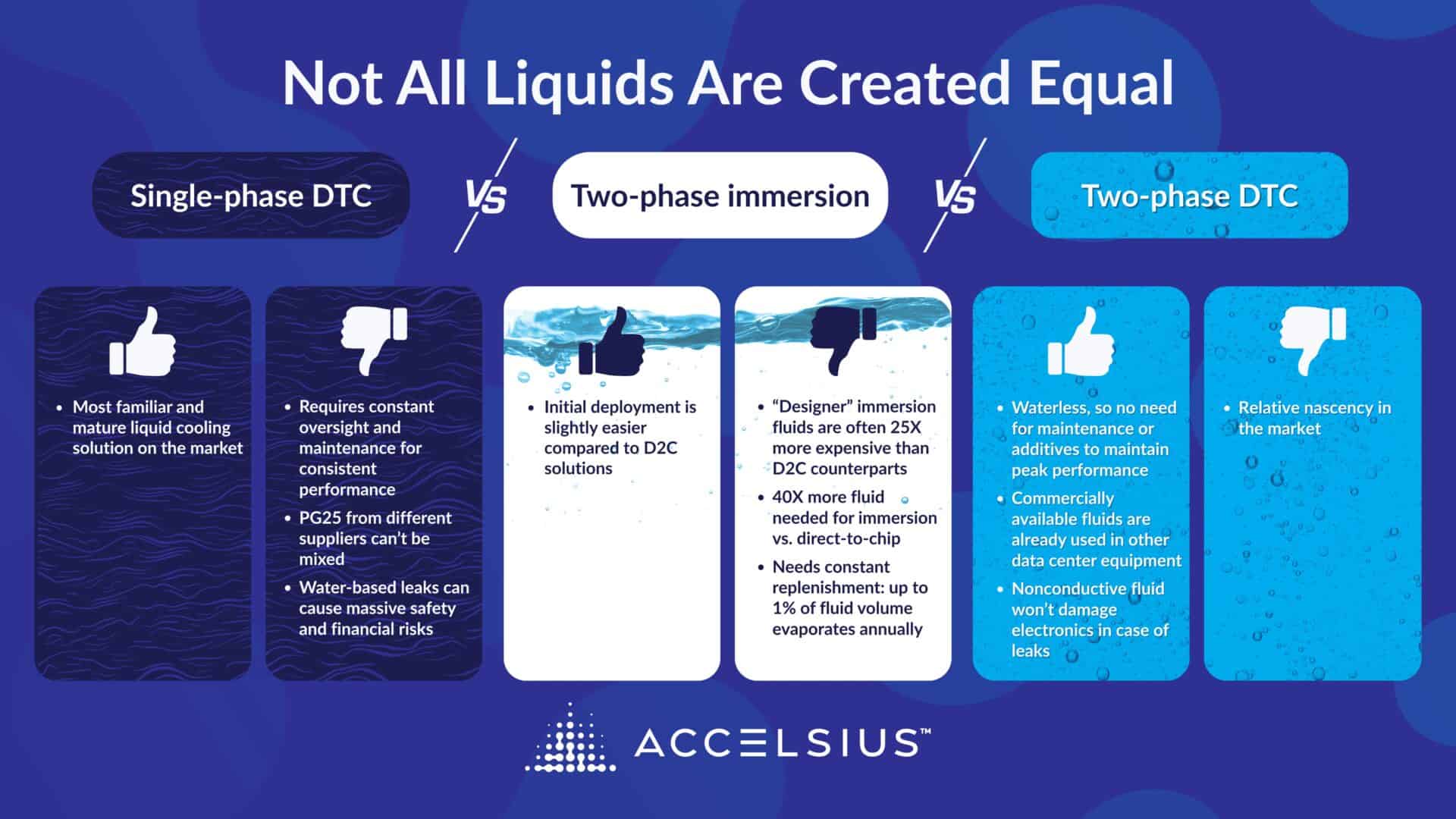
by
Lucas Beran
There’s an underlying question at the heart of the phrase “liquid cooling”—just what, exactly, is the liquid (or liquids) we increasingly rely upon to handle our cooling?
As liquid cooling’s popularity begins to reach a boiling point within the data center industry—with industry analysts declaring liquid cooling will “go mainstream” by 2025—it’s vital to consider this question now before adoption rates skyrocket. Any cooling myths or misconceptions that aren’t dispelled prior to implementation could lead to poorer thermal performance or aggravated TCOs or even total system failure.
Because the truth is this: you aren’t just adopting a liquid cooling solution; you’re also adopting the liquid itself. And as we’ll soon explore, no fluid on the market is a “silver bullet,” manufactured to effortlessly tackle the thermal demands of NVIDIA’s NVL576 racks (using up to 600kW of power) with zero strings attached. Three of the most popular liquid cooling methods (i.e., two-phase immersion, single-phase direct-to-chip, and two-phase direct-to-chip) utilize fluids that all come equipped with their own unique strengths and drawbacks.
Whether each fluid’s strengths are worth their drawbacks, however—that’s another matter entirely.
Single-Phase Direct-to-Chip: High Performance, Higher Maintenance
While single-phase direct-to-chip (D2C) may appear to be the incumbent solution on the market, largely due to its maturity and familiarity, its fluids’ nominally stronger thermal performance is easily offset by the amount of vigilance and maintenance required to keep it at its best.
The incessant oversight associated with single-phase D2C is largely due to its reliance on water—either as deionized “pure” water, or in a “PG25” mixture composed of 75% water and 25% propylene glycol. While PG25 reduces the maintenance burdens associated with water, PG25 fluids from different suppliers can’t be mixed—and no matter what, any cooling fluid that utilizes water will ultimately demand constant servicing throughout its lifecycle.
That’s because water is a double-edged sword: its potential for thermal conductivity rests alongside its profound risks of corrosion and biofouling, requiring frequent testing and filter changes, and the addition of biocides and inhibitors to prevent the worst. Left unchecked, organic growths or corroded tubing in single-phase D2C systems can lead to inhibited performance—or even financial ruin. We’ve written elsewhere about what happens when single-phase leaks occur in a rack populated with high-end GPUs. In short, it can lead to millions’ worth of AI investments down the drain in a matter of seconds.
Ultimately, data center operators looking for a “set-it-and-forget-it” cooling solution should look elsewhere. Water’s fickle nature requires constant care—otherwise, it’s easily outclassed.
Two-Phase Immersion: High Costs, High Risks
What typically comes to mind when you hear the word “designer”?
“Expensive” and “exclusive” are words usually associated with all things designer—and two-phase immersion’s designer fluids are no different.
Any fluid used in a two-phase immersion system is designed with specific characteristics to accommodate specific applications—and that emphasis on specificity comes with a heavy price tag. Most two-phase immersion fluids are often 25X more expensive than their direct-to-chip counterparts; furthermore, given that you need enough fluid to fully immerse your critical infrastructure, you’ll have to buy approx. 40X more fluid vs. direct-to-chip. Even after the initial setup, you won’t be finished buying fluid: Up to 1% of its total volume is lost annually due to evaporation and will promptly need to be replaced, considerably increasing OPEX over time.
Simply put, two-phase immersion’s fluids demand specialized infrastructure requirements to combat their inherent volatility—and even if everything’s calibrated exactly right, you’ll still need to pay for fluids for years to come.
Two-Phase Direct-to-Chip: Precision Performance, Expert Engineering
Fortunately, there’s a liquid cooling method whose fluid properly overcomes other fluids’ weaknesses. Despite its relative nascency in the market, two-phase, direct-to-chip utilizes a dielectric or nonconductive refrigerant that offer key advantages compared to its competitors:
- Entirely waterless: Two-phase DTC’s refrigerant requires none of the maintenance demands associated with water—meaning there’s no need to manage biocides, inhibitors, or other additives to achieve peak performance.
- Commercially available: These aren’t designer fluids—in fact, two-phase DTC refrigerants are already used in other data center equipment (like chillers).
- Sealed system: Two-phase DTC utilizes a closed-loop system designed for minimal fluid loss. Plus, even in the event of a leak, the refrigerant’s nonconductive nature means leaks won’t damage electronics or lead to operational downtime.
At Accelsius, we utilize proprietary refrigerants that deliver all of the above. Both our Eco+ (R-1233zd(E)) and Performance+ (R-515B) refrigerants also share the following properties:
- Non-corrosive, non-flammable, and non-toxic
- ASHRAE A1 safety rating
- 0 Ozone Depletion Potential (ODP)
- Low GWP
- Used in data center, industrial process, and comfort cooling applications
- Meets the industry’s sustainability requirements
- Supplied by Honeywell
As you’ve no doubt noticed, best-of-class performance isn’t our only concern—we’ve also ensured our fluids are safe and sustainable for you and your environment.
Choose Your Coolant Wisely
When it comes to liquid cooling, don’t just go with the flow—ensure you’re choosing the right liquid that keeps your data center performing, protected, and future-proofed.
In a side-by-side comparison, the results speak for themselves: two-phase, direct-to-chip’s dielectric refrigerants strike the strongest balance of performance and sustainability alongside a low TCO and lower operational overhead.
